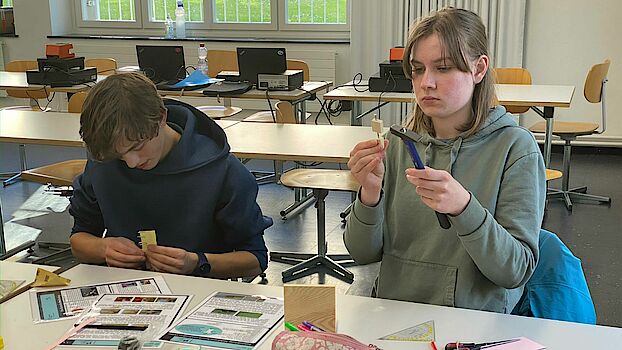/ Berichte, SNI INSight
AFM workshop – An offer from the SNI
It’s hard to imagine the world of modern research without atomic force microscopes (AFMs). These instruments help researchers around the world to shed light on physical, chemical and biological processes by visualizing the world of atoms and molecules and supporting all kinds of analytical processes.
The students made a wooden model of an atomic force microscope to understand the principle of operation. (Image: M. Wegmann, SNI)For school classes, the SNI has offered workshops on atomic force technology for some time — and a class from the Kirschgarten high school recently took up this offer.
For school classes, the SNI has offered workshops on atomic force technology for some time — and a class from the Kirschgarten high school recently took up this offer.
“We received a fascinating introduction to atomic force microscopy from the SNI outreach team and had the chance to dive into the micro and nano cosmos for ourselves using the portable AFMs provided by the SNI,” says Sarah Müller, a teacher at the Kirschgarten high school who has a degree in nanosciences from the University of Basel. Together with her colleague Dan-Felix Scherrer (who also has a master’s degree in nanosciences from Basel), Sarah developed a course for her students to help them gain a better understanding of this totally alien world of tiny structures and nano phenomena.
The SNI’s two outreach managers, Dr. Kerstin Beyer-Hans and Dr. Michèle Wegmann, adapt the workshop to the wishes of their target group. In most cases, they begin by building a wooden model of the AFM together with the students in order to illustrate how the instrument works.
Portable AFMs are then used to show the students how measurements are actually performed, allowing them to see the indentations (pits) on a CD, the irregularities on a butterfly’s wing, or the fine details of folded DNA for the first time.
“We got a great introduction to atomic force microscopy from the SNI outreach team and were also able to dive into the micro- and nanocosmos ourselves with the portable AFMs provided by the SNI.”
Sarah Müller, teacher at the Kirschgarten high school
who has a degree in nanosciences from the University of Basel

